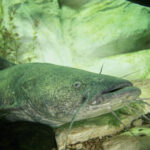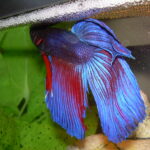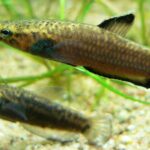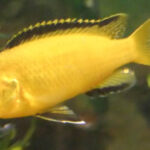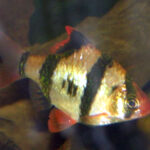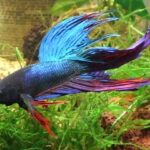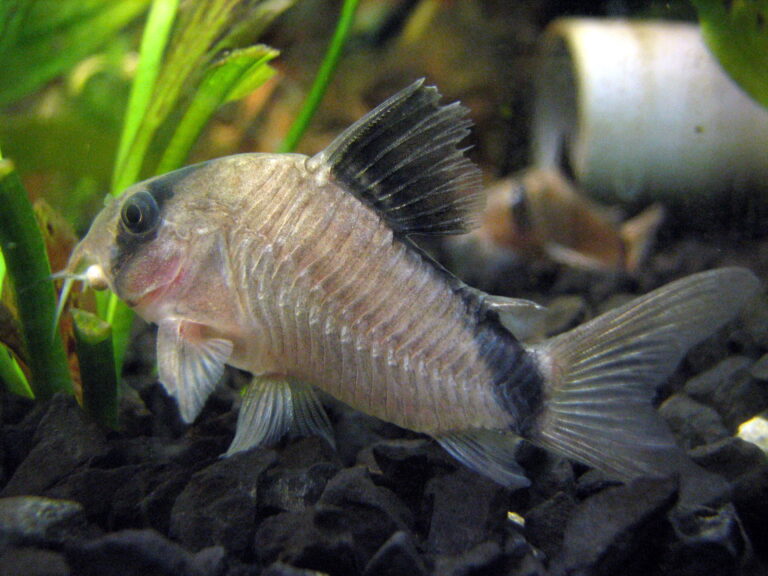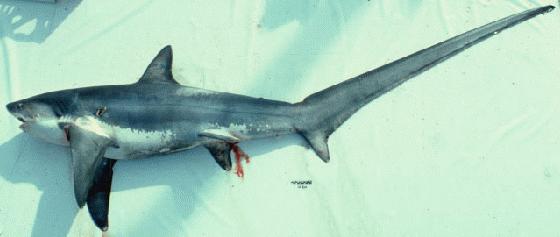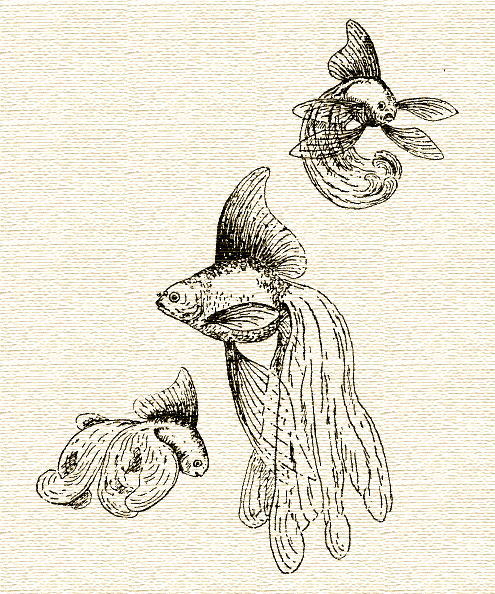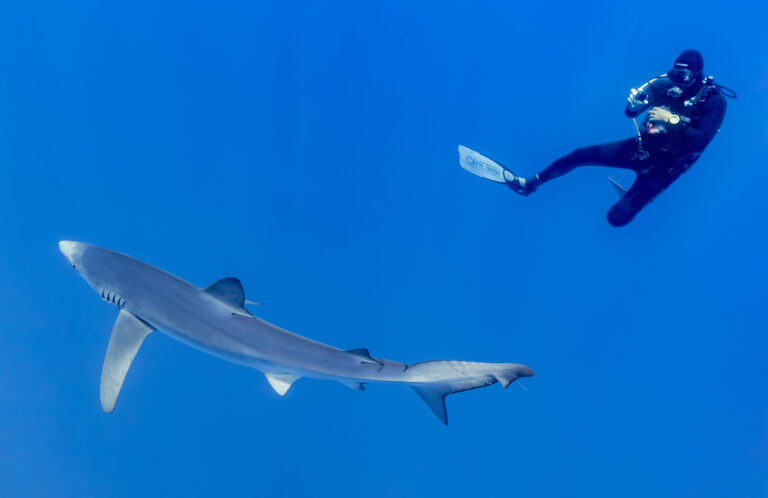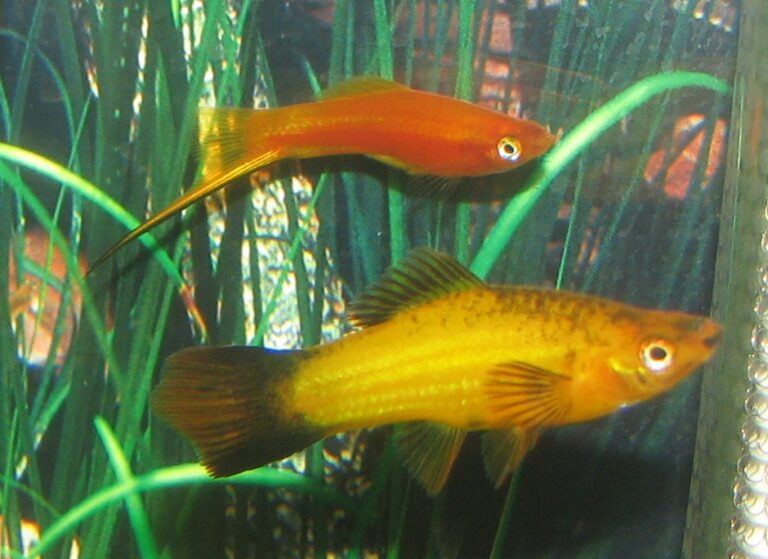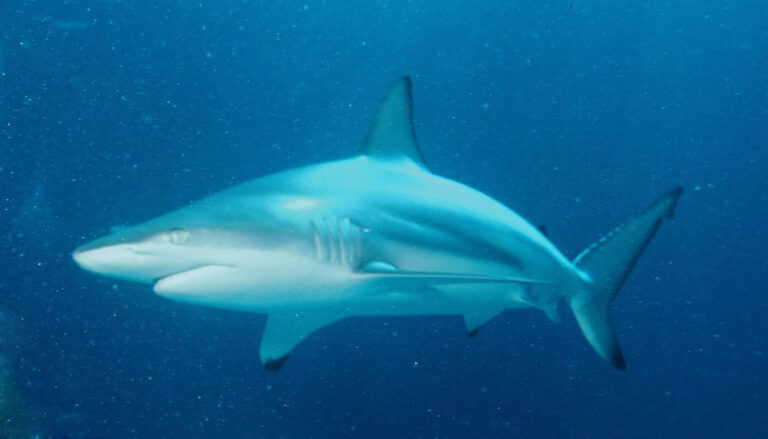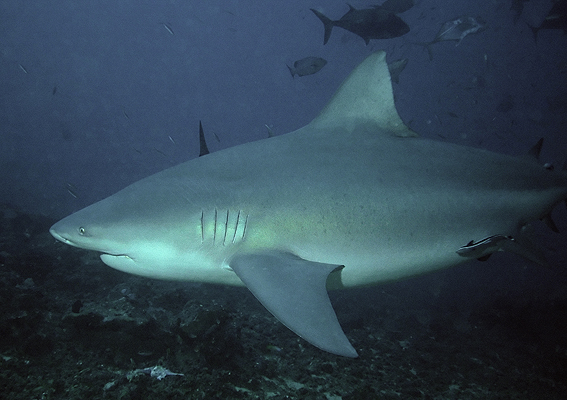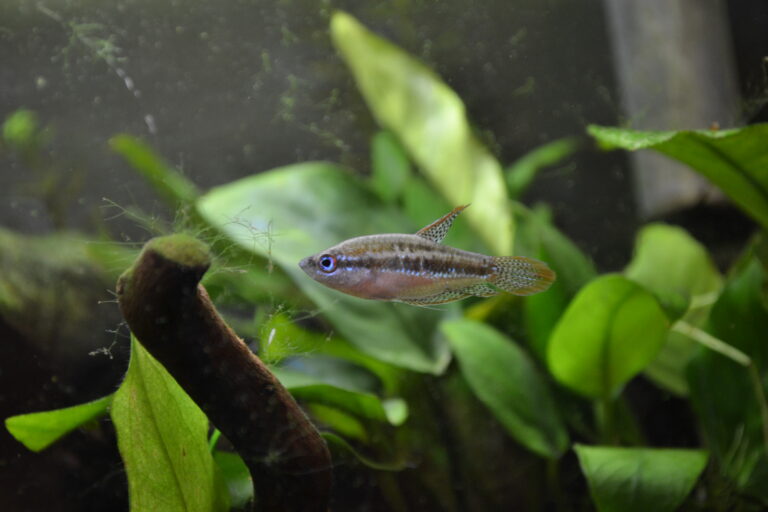Half Moon Betta
By Ryan Maron | Last Modified: June 10, 2025
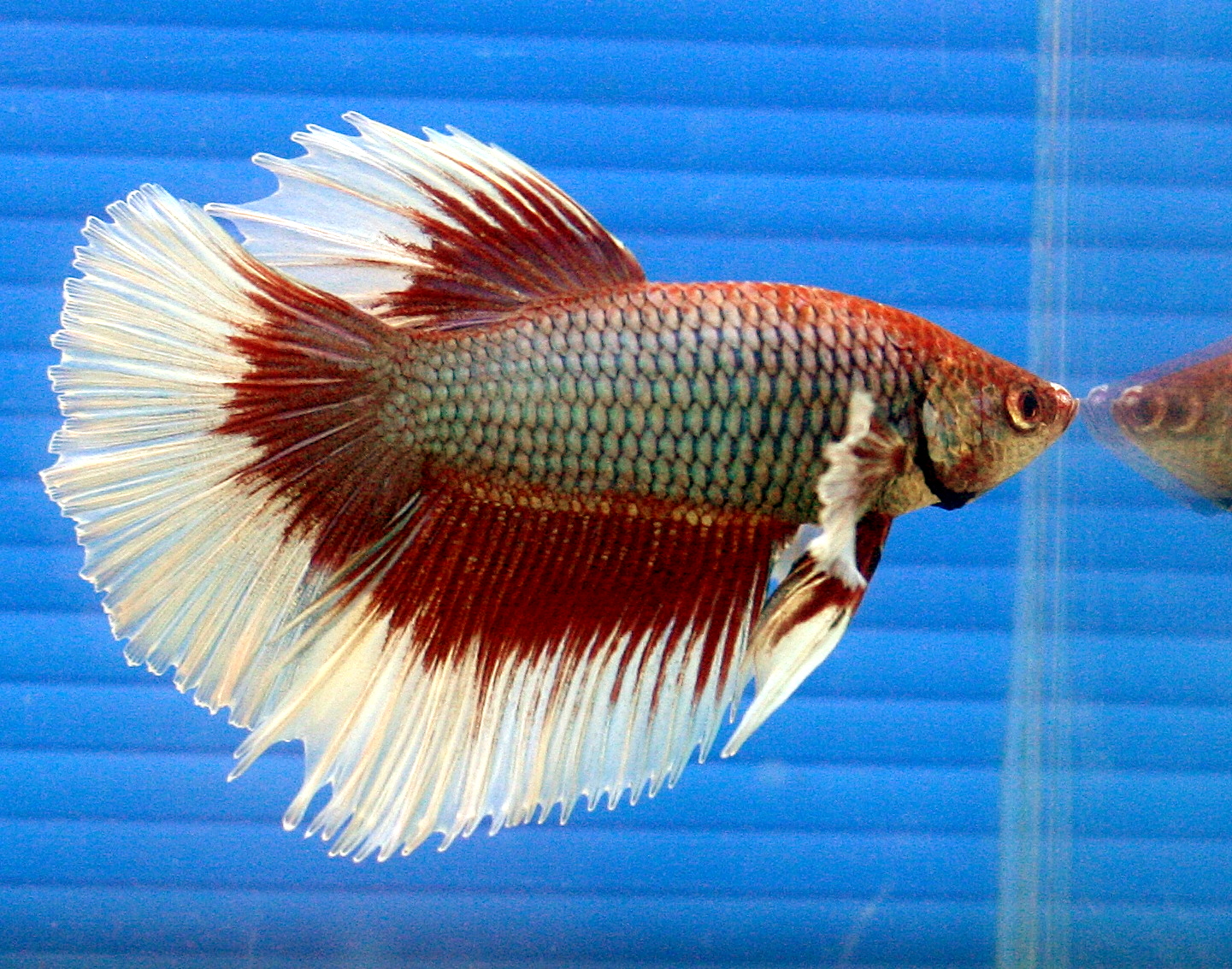
The Half Moon Betta (Betta splendens) represents one of the most distinctive and sought-after varieties within the Siamese fighting fish lineage. Distinguished by its semicircular caudal fin that spans precisely 180 degrees when fully extended, this ornamental fish has captured the attention of aquarists and breeders worldwide. Named for its characteristic tail shape that resembles a crescent moon, the Half Moon Betta exemplifies the remarkable phenotypic diversity achievable through selective breeding programs.
As a member of the labyrinth fish family, the Half Moon Betta serves as an important species in the global aquarium trade, contributing significantly to the ornamental fish industry valued at over $15 billion annually. Beyond its commercial importance, this variety demonstrates fascinating adaptations to oxygen-poor environments and exhibits complex behavioral patterns that provide insights into territorial aggression, courtship rituals, and parental care strategies. The species plays a crucial role in aquatic ecosystems as both predator and prey, controlling mosquito larvae populations while serving as food for larger fish species in their native habitats.
| Feature | Details |
|---|---|
| Common Name | Half Moon Betta |
| Scientific Name | Betta splendens |
| Family | Osphronemidae |
| Typical Size | 6-8 cm (2.5-3 inches), 2-5 grams |
| Habitat | Shallow freshwater environments |
| Diet | Carnivorous – insects, larvae, small crustaceans |
| Distribution | Southeast Asia, global aquarium trade |
| Conservation Status | Least Concern |
Taxonomy & Classification
The Half Moon Betta belongs to the genus Betta within the family Osphronemidae, commonly known as gouramis. Originally described by Regan in 1910, Betta splendens has undergone extensive taxonomic revision as researchers have identified numerous species within the Betta complex. The Half Moon variety represents a specific phenotypic expression rather than a distinct subspecies, arising from selective breeding programs that began intensively in the 1990s.
Within the broader classification system, the Half Moon Betta falls under the order Anabantiformes, which encompasses all labyrinth fishes. This order is characterized by the presence of a specialized respiratory organ called the labyrinth, allowing these fish to extract oxygen directly from atmospheric air. The family Osphronemidae includes over 130 species distributed across four subfamilies, with Betta splendens representing the most widely recognized member.
Genetic studies have revealed that the Half Moon tail morphology results from specific allelic combinations affecting fin ray development and membrane formation. The trait follows a complex inheritance pattern involving multiple genetic loci, making consistent breeding outcomes challenging for aquaculturists. Modern molecular techniques have identified at least twelve genetic markers associated with tail shape variation in Betta splendens populations.
The species exhibits significant phenotypic plasticity, with different Betta fish varieties displaying remarkable diversity in coloration, fin structure, and behavioral characteristics. This diversity has led to the recognition of numerous commercial varieties, each with specific breeding standards maintained by international Betta associations.
Physical Description
The Half Moon Betta displays the most distinctive caudal fin architecture among all Betta varieties, with the tail forming a perfect 180-degree semicircle when fully extended. This impressive fin span can reach up to 4 centimeters in mature specimens, creating a dramatic silhouette that distinguishes it from other ornamental fish species. The caudal fin consists of branched rays supported by a complex network of muscles and connective tissues, allowing for precise control during swimming and display behaviors.
Body coloration in Half Moon Bettas encompasses virtually every hue imaginable, from deep royal blues and vibrant reds to subtle pastels and metallic sheens. The most prized specimens exhibit uniform color distribution across both body and fins, though many individuals display striking color gradients or contrasting patterns. Iridescent scales reflect light at multiple wavelengths, creating an almost jewel-like appearance under optimal lighting conditions.
The species exhibits pronounced sexual dimorphism, with males significantly larger and more colorful than females. Male Half Moon Bettas typically reach 7-8 centimeters in total length, while females remain smaller at 5-6 centimeters. Males possess elongated ventral fins that extend into thread-like projections, while females display shorter, more practical fin structures adapted for efficient swimming and egg-carrying behaviors.
Anatomical features include a laterally compressed body shape optimized for maneuvering through dense aquatic vegetation. The mouth is positioned terminally with a slightly upturned orientation, reflecting the species’ surface-feeding preferences. Specialized pharyngeal teeth allow for efficient processing of small invertebrate prey, while the labyrinth organ provides crucial respiratory flexibility in oxygen-poor environments.
Habitat & Distribution
Native Half Moon Betta populations originate from the Mekong River basin, encompassing portions of Thailand, Cambodia, Laos, and Vietnam. These fish naturally inhabit shallow, slow-moving waters including rice paddies, drainage ditches, floodplains, and temporary pools formed during monsoon seasons. Water temperatures in these environments typically range from 24-30°C, with pH levels between 6.0-7.5 and minimal water movement that allows for optimal labyrinth organ function.
The species demonstrates remarkable adaptability to varying water conditions, thriving in environments with dissolved oxygen levels as low as 2-3 mg/L. This physiological flexibility has enabled Half Moon Bettas to colonize diverse aquatic habitats, from heavily vegetated swamps to urban water retention systems. Natural substrates consist primarily of soft sediments rich in organic matter, supporting abundant populations of invertebrate prey species.
Seasonal flooding patterns significantly influence habitat availability and population dynamics. During dry seasons, Half Moon Bettas concentrate in permanent water bodies, leading to increased territorial competition and aggressive interactions. Conversely, wet season flooding expands available habitat and reduces population density, allowing for more dispersed territorial arrangements and reduced stress levels.
Human activities have substantially altered natural habitat conditions throughout the species’ range. Agricultural intensification, urban development, and water management projects have fragmented traditional breeding grounds and altered water chemistry profiles. Despite these pressures, wild populations remain stable due to the species’ remarkable environmental tolerance and reproductive resilience.
Diet & Feeding Behavior
Half Moon Bettas exhibit specialized carnivorous feeding behavior, primarily consuming small invertebrates found at the water surface and within the upper water column. Their natural diet consists of mosquito larvae, bloodworms, daphnia, cyclops, and various terrestrial insects that fall onto the water surface. The species demonstrates opportunistic feeding patterns, adjusting prey selection based on seasonal availability and environmental conditions.
Feeding behavior follows distinct patterns throughout the day, with peak activity occurring during dawn and dusk periods when prey density reaches maximum levels. Half Moon Bettas employ a combination of hunting strategies, including ambush predation near vegetation cover and active pursuit of mobile prey items. Their upturned mouth orientation facilitates efficient surface feeding, while keen eyesight allows for precise targeting of small prey items.
Digestive physiology reflects the species’ carnivorous specialization, with a relatively short intestinal tract optimized for protein processing. Stomach acid pH levels range from 1.5-2.0, enabling efficient breakdown of chitinous insect exoskeletons and crustacean shells. Feeding frequency in natural environments varies considerably based on prey availability, with individuals capable of surviving extended periods without food during resource-poor conditions.
Prey capture techniques involve rapid gill cover expansion and mouth opening, creating suction forces that draw small organisms into the oral cavity. Pharyngeal teeth processing allows for efficient handling of hard-bodied prey items, while sensitive taste buds enable discrimination between suitable and unsuitable food sources. This selective feeding behavior helps maintain optimal nutrition while avoiding potentially harmful organisms.
Behavior & Adaptations
Half Moon Bettas exhibit complex territorial behavior patterns that have evolved to maximize resource acquisition and reproductive success. Males establish and defend territories ranging from 0.5-2 square meters, depending on habitat quality and population density. Territorial boundaries are maintained through aggressive displays, including fin flaring, gill cover extension, and ritualized swimming patterns designed to intimidate potential intruders.
The species demonstrates remarkable behavioral flexibility in response to environmental challenges. During periods of habitat degradation or resource scarcity, Half Moon Bettas can modify their territorial requirements and adjust aggressive responses to conserve energy. This behavioral plasticity has contributed significantly to their success in diverse aquatic environments and artificial breeding systems.
Social hierarchy establishment occurs through complex behavioral interactions involving visual displays, chemical signaling, and physical confrontation when necessary. Dominant individuals typically secure prime territories with optimal feeding opportunities and shelter availability, while subordinate fish occupy marginal habitats with reduced resource access. These hierarchical arrangements help reduce overall population stress and optimize resource utilization.
Labyrinth organ adaptations enable survival in oxygen-depleted environments that would prove fatal to most other fish species. This physiological advantage allows Half Moon Bettas to exploit ecological niches unavailable to competitors, including heavily polluted urban waterways and seasonal pools with minimal dissolved oxygen. The ability to breathe atmospheric air provides crucial flexibility during environmental emergencies and habitat transitions.
Reproduction & Life Cycle
Half Moon Betta reproduction follows a complex courtship ritual that begins with elaborate male display behaviors designed to attract potential mates. Males construct bubble nests at the water surface using secreted mucoproteins and air bubbles, creating floating structures that serve as spawning sites and nurseries for developing embryos. Nest construction typically requires 24-48 hours, with males meticulously maintaining bubble integrity through continuous monitoring and repair activities.
Courtship behavior involves intricate swimming patterns, color intensification, and fin displays that demonstrate male fitness and genetic quality. Receptive females respond with submissive postures and color changes that signal breeding readiness. The spawning process occurs beneath the bubble nest, with males wrapping around females to facilitate egg fertilization and collection of released gametes.
Egg development proceeds rapidly at optimal temperatures, with hatching occurring within 24-36 hours post-fertilization. Newly hatched larvae remain attached to the bubble nest through specialized adhesive organs, receiving nutrition from attached yolk sacs during the first 48-72 hours of development. Male parental care includes fry protection, nest maintenance, and retrieval of displaced offspring that stray from the nursery area.
Juvenile development follows distinct stages marked by morphological changes and behavioral transitions. Free-swimming fry begin independent feeding approximately 4-5 days post-hatching, initially consuming microscopic organisms before gradually incorporating larger prey items. Sexual maturity is typically reached at 3-4 months of age, with optimal breeding condition occurring between 6-18 months in healthy individuals.
Predators & Threats
Natural predators of Half Moon Bettas include larger fish species, aquatic reptiles, amphibians, and various bird species that frequent shallow water environments. Snakeheads (Channidae), catfish species, and predatory cyprinids pose significant threats to adult populations, while juvenile fish face additional pressure from dragonfly larvae, water beetles, and other aquatic invertebrates. Avian predators such as herons, egrets, and kingfishers frequently target individuals in shallow, exposed habitats.
Habitat degradation represents the most significant long-term threat to wild Half Moon Betta populations. Agricultural chemical runoff, urban pollution, and water diversion projects have substantially reduced water quality in many traditional breeding areas. Pesticide contamination particularly affects reproductive success, as many compounds interfere with normal endocrine function and egg development processes.
Climate change impacts include altered precipitation patterns, increased temperature fluctuations, and more frequent extreme weather events that disrupt breeding cycles and habitat stability. Rising average temperatures may push some populations beyond their thermal tolerance ranges, while changing monsoon patterns affect critical spawning habitat availability during reproductive seasons.
Invasive species introduction has created new competitive pressures in some regions, with non-native fish species competing for limited resources and breeding sites. Additionally, collection pressure for the international aquarium trade has depleted some wild populations, though most commercial specimens now originate from captive breeding programs rather than wild collection activities.
Conservation Status
The International Union for Conservation of Nature (IUCN) currently classifies Betta splendens as Least Concern, reflecting the species’ stable wild populations and successful adaptation to human-modified environments. However, this classification masks significant regional variations in population health and habitat quality throughout the species’ native range.
Wild population monitoring programs conducted by regional fisheries departments indicate stable overall numbers, though some localized populations have experienced declines due to habitat degradation and pollution. The species’ remarkable environmental tolerance has enabled persistence in many areas where other native fish species have disappeared, suggesting inherent resilience to anthropogenic pressures.
Captive breeding programs have achieved remarkable success, with millions of Half Moon Bettas produced annually for the global aquarium trade. These breeding operations have reduced pressure on wild populations while maintaining genetic diversity through careful lineage management and periodic introduction of wild-caught breeding stock.
Conservation efforts focus primarily on habitat protection and water quality improvement rather than direct species management. Wetland restoration projects, agricultural runoff reduction programs, and urban water management improvements benefit Half Moon Betta populations while supporting broader ecosystem health objectives throughout Southeast Asia.
Human Interaction
Half Moon Bettas have maintained significant cultural importance throughout Southeast Asia for centuries, featuring prominently in traditional folklore, religious ceremonies, and competitive fighting exhibitions. Historical records indicate that Siamese royalty maintained elaborate Betta collections, with prize specimens serving as valuable diplomatic gifts and symbols of wealth and status.
The modern aquarium trade has transformed Half Moon Bettas into one of the most popular ornamental fish species worldwide, with annual sales exceeding 200 million specimens globally. Breeding programs have created hundreds of distinct varieties, each with specific characteristics that appeal to different segments of the aquarium hobby. Advanced breeding techniques have enabled the production of increasingly elaborate color patterns and fin configurations.
Competitive Betta showing has evolved into a sophisticated hobby with international standards and judging criteria. Organizations such as the International Betta Congress establish breeding standards and organize competitions that drive continued genetic improvement and phenotypic diversity. Prize-winning specimens can command prices exceeding $1,000, reflecting the significant investment in selective breeding programs.
Educational applications include use in genetics courses, behavioral studies, and aquaculture training programs. The species’ relatively simple care requirements and observable behaviors make it an ideal subject for teaching concepts related to animal husbandry, breeding principles, and aquatic ecosystem management.
Interesting Facts
Half Moon Bettas possess the remarkable ability to recognize individual humans and can be trained to perform simple behaviors in response to visual cues. Research has demonstrated that these fish can distinguish between different human faces and associate specific individuals with feeding times or other routine activities. Some specimens have learned to jump through hoops, navigate mazes, and respond to colored targets during training sessions.
The bubble nest construction behavior involves sophisticated engineering principles, with males adjusting bubble size and density based on environmental conditions such as water temperature, humidity, and surface tension. Nests can contain over 1,000 individual bubbles, each carefully positioned to create optimal conditions for egg development and fry protection.
Genetic studies have revealed that Half Moon Bettas possess color vision capabilities extending into the ultraviolet spectrum, allowing them to perceive patterns and markings invisible to human observers. This enhanced visual system plays crucial roles in mate selection, territorial recognition, and predator detection in their natural environments.
The species exhibits remarkable longevity for a small tropical fish, with properly maintained specimens living up to 5-7 years in captivity. This extended lifespan allows for complex behavioral development and learning, with older individuals often displaying more sophisticated territorial strategies and social interactions than younger fish.
Physiological adaptations include the ability to rapidly adjust metabolic rates in response to environmental conditions, enabling survival in habitats with extreme temperature fluctuations or resource scarcity. During unfavorable conditions, Half Moon Bettas can reduce their metabolic rate by up to 40%, extending survival periods significantly.
Frequently Asked Questions
How long do Half Moon Bettas typically live in captivity?
Half Moon Bettas generally live 3-5 years in captivity with proper care, though exceptional specimens have reached 7 years. Lifespan depends on water quality, diet, temperature stability, and genetic factors. Males typically live slightly longer than females due to reduced reproductive stress in aquarium environments.
What distinguishes a Half Moon Betta from other Betta varieties?
The defining characteristic is the caudal fin that forms a perfect 180-degree semicircle when fully extended. This creates a distinctive half-moon shape that sets it apart from other varieties like crowntails, veiltails, or delta-tails. The tail should maintain its shape consistently and show no gaps or irregularities in the fin membrane.
Can Half Moon Bettas survive in small containers or bowls?
While Half Moon Bettas can survive in small containers due to their labyrinth organ, they require at least 2.5-5 gallons for optimal health and behavior. Larger volumes provide better water stability, more swimming space, and opportunities for natural behaviors. Small containers restrict movement and can lead to stress-related health issues.
Do Half Moon Bettas require special water conditions?
Half Moon Bettas prefer slightly acidic to neutral water with pH between 6.5-7.5 and temperatures of 76-82°F. They tolerate various water conditions but perform best in soft to moderately hard water with minimal current. Regular water changes and proper filtration maintain optimal conditions for health and coloration.
Conclusion
The Half Moon Betta stands as a testament to both natural evolutionary adaptability and human selective breeding achievements, representing one of the most recognizable and culturally significant freshwater fish species. Its distinctive semicircular tail fin, vibrant coloration, and complex behavioral repertoire have secured its position as a cornerstone species in the global aquarium trade while maintaining stable wild populations throughout Southeast Asia. The species’ remarkable physiological adaptations, including the specialized labyrinth organ and exceptional environmental tolerance, continue to provide valuable insights for researchers studying fish biology, behavior, and conservation strategies in rapidly changing aquatic ecosystems.
Share The Article:
More Fish Species:
-
Corydoras Catfish
Corydoras catfish represent one of the most diverse and ecologically significant groups of freshwater bottom-dwelling fish in South American…
-
Red Devil Cichlid
The Red Devil Cichlid stands as one of Central America’s most formidable and captivating freshwater predators, renowned for its…
-
Thresher Shark
The Thresher Shark represents one of the ocean’s most distinctive and captivating apex predators, renowned for its extraordinarily elongated…
-
Veiltail Goldfish
The Veiltail Goldfish stands as one of the most distinctive and graceful varieties within the goldfish family, renowned for…
-
Blue Shark
The Blue Shark (Prionace glauca) represents one of the ocean’s most accomplished travelers, traversing entire ocean basins in epic…
-
Swordtail Fish
The Swordtail Fish (Xiphophorus hellerii) stands as one of the most recognizable and beloved species in the aquarium trade,…
Discover
-
Fly Fishing in the UK: Top Rivers and Seasonal Patterns
After nearly three decades casting flies across waters from Michigan to Maine – and now spending several weeks each…
-
Pennsylvania Fishing License: Complete Guide for Anglers in 2025
Getting your Pennsylvania fishing license sorted isn’t exactly the most exciting part of fishing, but it’s absolutely necessary if…
-
Blacktip Shark
The Blacktip Shark (Carcharhinus limbatus) stands as one of the most recognizable and ecologically significant predators in tropical and…
-
Types of Ocean Fishing: Complete Guide for Beginners
There’s something magical about standing at the edge of the vast ocean with a fishing rod in hand. I’ve…
-
Bull Shark
The Bull Shark represents one of the most formidable apex predators in marine ecosystems worldwide. Known scientifically as Carcharhinus…
-
Bigeye Thresher Shark
The Bigeye Thresher Shark represents one of the ocean’s most extraordinary predators, distinguished by its dramatically elongated tail fin…
Discover
-
Great White Shark
The Great White Shark (*Carcharodon carcharias*) stands as one of the ocean’s most formidable apex predators, commanding respect and…
-
Unlock Killer Saltwater Jigging Techniques: What I’ve Learned After Thousands of Drops
The first time I tried saltwater jigging, I was on my buddy Dave’s boat in the Gulf of Mexico…
-
Sparkling Gourami
The Sparkling Gourami represents one of the most captivating miniature freshwater species available to aquarium enthusiasts and serves as…
-
King Mackerel Fishing: Top Strategies for Landing Smokers
Some days on the water just stick with you. Few things compare to that first time a king mackerel…
-
North Jersey Fishing Guide: Best Lakes, Rivers & Seasons
If you’ve never experienced the fishing in North Jersey, you’re missing out on some genuinely underrated angling opportunities. From…
-
How to Set Up a Fishing Pole For Beginners
After three decades of teaching friends and family how to fish, I’ve learned that setting up a fishing pole…


